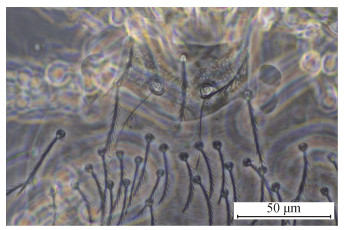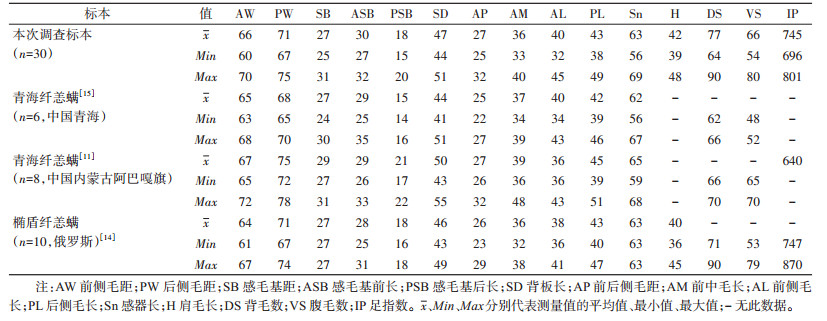扩展功能
文章信息
- 董利, 李贵昌, 王彬, 鲁亮, 赵宁, 宛新荣, 刘伟, 胡斌, 兴安, 李庆多, 李超, 王振旭, 张璐, 刘雨秋, 马德龙, 潘劲超, 何宏轩, 马伟, 刘起勇
- DONG Li, LI Gui-chang, WANG Bin, LU Liang, ZHAO Ning, WAN Xin-rong, LIU Wei, HU Bin, XING An, LI Qing-duo, LI Chao, WANG Zhen-xu, ZHANG Lu, LIU Yu-qiu, MA De-long, PAN Jin-chao, HE Hong-xuan, MA Wei, LIU Qi-yong
- 内蒙古自治区东部草原鼠体寄生恙螨调查
- An investigation of chigger mites on rodents in the grasslands of eastern Inner Mongolia Autonomous Region, China
- 中国媒介生物学及控制杂志, 2022, 33(6): 873-878
- Chin J Vector Biol & Control, 2022, 33(6): 873-878
- 10.11853/j.issn.1003.8280.2022.06.021
-
文章历史
- 收稿日期: 2022-08-18
2 中国疾病预防控制中心传染病预防控制所媒介生物 控制室, 传染病预防控制国家重点实验室, 北京 102206;
3 佳木斯大学公共卫生学院, 黑龙江 佳木斯154007;
4 中国科学院动物研究所, 北京 100101;
5 内蒙古民族大学农学院, 内蒙古 通辽 028043
2 State Key Laboratory of Infectious Disease Prevention and Control, Department of Vector Biology and Control, National Institute for Communicable Disease Control and Prevention, Chinese Center for Disease Control and Prevention, Beijing 102206, China;
3 Public Health School, Jiamusi University, Jiamusi, Heilongjiang 154007, China;
4 Institute of Zoology, Chinese Academy of Sciences, Beijing 100101, China;
5 Agricultural College, Inner Mongolia Minzu University, Tongliao, Inner Mongolia 028043, China
恙螨幼虫寄生于脊椎动物体表,部分种类可以叮咬人,引起皮炎。有的种类还能传播恙虫病东方体(Orientia tsutsugamushi,Ot),是恙虫病的传播媒介和储存宿主[1-2]。了解恙螨种类、宿主和时空分布是预防其危害的前提。近年国内外恙虫病发病均呈上升趋势[3-6]。在内蒙古自治区(内蒙古)鄂尔多斯市、阿拉善盟和呼伦贝尔市健康人群和包头市羊、马、鼠等动物血清中曾检出Ot IgG抗体阳性,在呼伦贝尔市鼠脾脏中检出Ot核酸片段阳性[7],近年来也有人间病例的报道[3, 5]。因此,内蒙古地区也存在恙虫病本地流行的可能性。内蒙古位于我国北部,大部分位于蒙古高原,既往记录恙螨17种[8-11],但相较全区广阔地域和多样的生态类型,大多数区域尚无恙螨调查记录,至今未见其时空分布规律的调查报告。为了评估当地恙虫病风险,指导传染病防控,2021年本课题组在内蒙古东部草原地区开展了鼠体恙螨的调查。
1 材料与方法 1.1 调查点选择和宿主动物捕获方法本次调查在内蒙古东部锡林郭勒盟(锡盟)、呼伦贝尔市、通辽市的草原生境,按照南北气候梯度和东西降水梯度分别选择南北方向5个点(N1~N5)和东西方向4个点(W1~W4,其中W2和N3共用),共8个调查点(图 1)。每个调查点选择代表性样地布放300只大号钢板鼠夹(190 cm×80 cm),并在每个样地选择鼠类数量较多的样地布放100只鼠笼。采用5 m夹线法,以生花生米为诱饵,连续布放2昼夜。每日早晚各检查1次,将捕获鼠连同鼠夹或鼠笼一起放入鼠布袋中,扎紧袋口,带回实验室,鉴定鼠种。2021年5、7、9月各调查1次。

|
| 注:N1呼伦贝尔市新巴尔虎右旗;N2锡林郭勒盟东乌珠穆沁旗;N3/W2锡林郭勒盟锡林浩特市朝克乌拉苏木;N4锡林郭勒盟锡林郭勒市白音锡勒牧场;N5锡林郭勒盟太仆寺旗;W1锡林郭勒盟阿巴嘎旗;W3锡林郭勒盟西乌珠穆沁旗;W4通辽市科尔沁左翼中旗和扎鲁特旗。 图 1 2021年内蒙古自治区东部草原调查地点分布 Figure 1 Distribution of survey sites in the grasslands of eastern Inner Mongolia, 2021 |
| |
捕获鼠用乙醚或异氟烷麻醉后,现场梳捡鼠体表寄生虫,检查并剪下鼠体有恙螨寄生的鼠耳等部位,标本保存在液氮或干冰中,带回实验室存于-80 ℃冰箱中。在显微镜下将鼠耳等部位恙螨挑取至离心管中,用霍氏封片液制作恙螨玻片标本[12]。根据相关文献进行恙螨形态学种类鉴定[12-14]。
1.3 数据整理和统计学分析利用Excel 2019软件进行数据整理、计算和绘制图表,用ArgGIS 10.0软件绘制地图,用SPSS 26.0软件进行χ2检验,P < 0.05为差异有统计学意义。用鼠体带恙螨率和恙螨指数作为恙螨密度的指标,计算公式如下:

|
本次调查捕获并检查鼠类9种672只,包括布氏田鼠(Lasiopodomys brandtii)、达乌尔黄鼠(Spermophilus dauricus)、黑线仓鼠(Cricetulus barabensis)、长爪沙鼠(Meriones unguiculatus)、蒙古毛足鼠(Phodopus campbelli)、五趾跳鼠(Allactaga sibirica)、子午沙鼠(Me. meridianus)、小家鼠(Mus musculus)和小毛足鼠(P. roborovskii),分别占捕获总数的44.64%、29.31%、11.76%、12.20%、0.30%、0.45%、0.59%、0.45%和0.30%。
在鼠体表共采集恙螨1 232只,其中较完整的1 210只标本鉴定为2科3属3种,其中恙螨科椭盾纤恙螨(Leptotrombidium oblongatum)1 174只、粗棒囊棒恙螨(Ascoschoengastia crassiclava)21只、列恙螨科鼠兔多毛恙螨(Multisetosa ochotonae)15只,分别占采获总数的97.02%、1.74%和1.24%,椭盾纤恙螨为调查地区的优势恙螨。
椭盾纤恙螨背板后缘呈圆形突出,肩毛2~3对,足3基节毛3~6根。将俄罗斯的椭盾纤恙螨[14]与我国青海省[15]、内蒙古[11]采集的青海纤恙螨(L. tsinghaiense)标本比较,其特征描述基本一致,本调查采集标本变异更大一些(图 2,表 1、2)。

|
| 图 2 椭盾纤恙螨背板及前部背毛 Figure 2 The tergum and anterior dorsal setae of Leptotrombidium oblongatum |
| |

|

|
携带恙螨的鼠共106只,总带恙螨率为15.77%,恙螨指数为1.80。不同鼠种的带恙螨率差异有统计学意义(χ2=573.114,P < 0.001)。恙螨的主要宿主鼠种为布氏田鼠、黑线仓鼠和长爪沙鼠,其携带恙螨数量分别占恙螨总数的74.38%、13.06%和12.48%,达乌尔黄鼠体表恙螨仅占0.08%,其余鼠体未发现恙螨。布氏田鼠、黑线仓鼠和长爪沙鼠均可携带椭盾纤恙螨和鼠兔多毛恙螨,而粗棒囊棒恙螨宿主仅发现于布氏田鼠和黑线仓鼠。带恙螨率最高的是长爪沙鼠(25.61%),而布氏田鼠恙螨指数最高(3.00)。见图 3A、B。

|
| 图 3 2021年内蒙古自治区东部草原不同鼠种体表带恙螨率和恙螨指数 Figure 3 The infestation rate and index of chigger mites on various species of rodents in the grasslands of eastern Inner Mongolia, 2021 |
| |
不同调查点鼠体带恙螨率差异有统计学意义(χ2=188.149,P < 0.001)。带恙螨率和恙螨指数从北向南先升高后下降,北部N2最高,其次是N1,分别占总恙螨数的91.16%和8.18%,带恙螨率分别为66.37%和11.06%,恙螨指数分别为9.76和0.48,两地鼠体带恙螨率差异无统计学意义(χ2=0.000,P=1.000);南部3个点中只有N4检出恙螨。东西方向带恙螨率和恙螨指数均极低或未检获恙螨,无明显变化趋势(图 4)。椭盾纤恙螨分布在除N3(W2)、N5以外的6个调查点,以N2、N1带螨率较高,其余2种恙螨只分布在N1、N2。见表 3、图 4。

|
| 注:N1呼伦贝尔市新巴尔虎右旗;N2锡林郭勒盟东乌珠穆沁旗;N3/W2锡林郭勒盟锡林浩特市朝克乌拉苏木;N4锡林郭勒盟锡林郭勒市白音锡勒牧场;N5锡林郭勒盟太仆寺旗;W1锡林郭勒盟阿巴嘎旗;W3锡林郭勒盟西乌珠穆沁旗;W4通辽市科尔沁左翼中旗和扎鲁特旗。 图 4 2021年内蒙古自治区东部草原不同调查点鼠体带恙螨率和恙螨指数 Figure 4 The infestation rate and index of chigger mites on the rodents in various survey sites in the grasslands of eastern Inner Mongolia, 2021 |
| |

|
在N2和N1两个调查点恙螨密度最高,恙螨数量占总数的99.34%。而这2个点的布氏田鼠(80.56%)、长爪沙鼠(15.36%)和黑线仓鼠(3.45%)3种鼠数量占总数的99.37%(319/321),这3种鼠也是本次采获恙螨的主要宿主。
2.4 不同月份恙螨分布情况在5、7、9三个月鼠体均可检出恙螨,鼠体带恙螨率和恙螨指数随月份均呈明显的升高趋势(图 5A、B),9月鼠体带恙螨率和恙螨指数最高,分别为33.67%和4.01。不同月份的鼠体带恙螨率差异有统计学意义(χ2=85.777,P < 0.001)。椭盾纤恙螨在调查的3个月均可检出,而鼠兔多毛恙螨和粗棒囊棒恙螨只在7和9月有检出。

|
| 图 5 内蒙古自治区东部草原2021年不同月份鼠体带恙螨率和恙螨指数 Figure 5 The infestation rate and index of chigger mites on the rodents in various months in the grasslands of eastern Inner Mongolia, 2021 |
| |
内蒙古东部大草原地域广阔,是我国主要牧区,也是草原旅游的最佳区域。此区域气候特点是自东向西降水递减,自南向北温度逐渐降低。动物地理区划属于古北界蒙新区东部草原亚区,分布有长爪沙鼠、布氏田鼠、达乌尔黄鼠和西伯利亚旱獭(Marmota sibirica)为宿主的多种类型的鼠疫疫源地。在疫源地调查和监测过程中积累了丰富的鼠、蚤的调查数据,但对鼠体恙螨只有零星记载。本次调查以内蒙古东部草原为调查区域,空间上分为东西和南北2条线,时间上包括春、夏、秋3个季节,从地理和季节两个方面分析其对恙螨的影响。
调查结果显示,该区域5、7、9月鼠体仅有3种恙螨。粗棒囊棒恙螨在国内初次发现于内蒙古的短尾仓鼠(Cricetulus eversmanni)和长爪沙鼠鼠体[10],本次调查宿主增加了布氏田鼠。鼠兔多毛恙螨分布于青海省黄土高原亚区、藏南亚区[16-17]和新疆维吾尔自治区奇台县[18],本调查首次在内蒙古地区发现该螨。椭盾纤恙螨是调查区域的优势恙螨种,该螨由Schluger和Emeljanova(1957年)首次记录,分布于俄罗斯东西伯利亚南部的后贝加尔、赤塔、布里亚特、图瓦地区以及蒙古国中东部[13]。Кудряшова[14]将其与其他类似种建立猛突恙螨属(Montivagum),但Stekolnikov[13]仍认为该恙螨应归入纤恙螨属。青海纤恙螨由莫乘风[15]描述(1965年),分布于青海省的藏南亚区和黄土高原亚区、宁夏回族自治区的盐池和海原县[19],在内蒙古的阿巴嘎旗也有记录[11]。Кудряшова[14]比较了青海纤恙螨和椭盾纤恙螨特征,认为青海纤恙螨为椭盾纤恙螨的同物异名。本课题组将本次捕获的标本与俄罗斯和我国青海省、内蒙古的标本特征相比较,形态特征基本一致,认为二者是同一物种。椭盾纤恙螨分布于8个调查点中的6个,包括已有记录的阿巴嘎旗,但主要分布在临近中国-蒙古国-俄罗斯(中蒙俄)边境的2个调查点,与国外分布区接近。
椭盾纤恙螨的鼠体带螨率和恙螨指数在靠近中蒙边境的东乌珠穆沁旗和中蒙俄边境的新巴尔虎右旗较高,在东部和南部很少,结合国内外该螨分布区域[13],可见该螨适宜区域是海拔1 000~3 000 m的山区和高原、偏冷的气候区。椭盾纤恙螨幼虫在调查地区5-9月均有分布,但9月密度最高。这与俄罗斯的调查结果类似。该恙螨在春、夏、秋季草原放牧活动和旅游高峰季节均持续存在,与人类接触机会较多。同时该螨宿主多样,包括多种鼠类、鼠兔和刺猬,属于广宿主型,能侵袭多种动物,当地牧民和游客均有被恙螨侵害的风险。因此应针对该地的野生动物、家畜和人群恙虫病血清学和病原学开展调查,研究椭盾纤恙螨自然携带、传播病原体和叮咬人的能力,评估该地区发生恙虫病的风险,为当地疾病防控提供科学依据。
利益冲突 无
| [1] |
Xu G, Walker DH, Jupiter D, et al. A review of the global epidemiology of scrub typhus[J]. PLoS Negl Trop Dis, 2017, 11(11): e0006062. DOI:10.1371/journal.pntd.0006062 |
| [2] |
李贵昌, 刘起勇. 恙虫病的流行现状[J]. 疾病监测, 2018, 33(2): 129-138. Li GC, Liu QY. Epidemic trend of scrub typhus in the world[J]. Dis Surveill, 2018, 33(2): 129-138. DOI:10.3784/j.issn.1003-9961.2018.02.006 |
| [3] |
李贵昌, 栗冬梅, 李焱, 等. 2006-2016年我国恙虫病流行特征分析[J]. 疾病监测, 2018, 33(2): 139-143. Li GC, Li DM, Li Y, et al. Epidemiology of scrub typhus in China, 2006-2016[J]. Dis Surveill, 2018, 33(2): 139-143. DOI:10.3784/j.issn.1003-9961.2018.02.007 |
| [4] |
Richards AL, Jiang J. Scrub typhus: Historic perspective and current status of the worldwide presence of Orientia species[J]. Trop Med Infect Dis, 2020, 5(2): 49. DOI:10.3390/tropicalmed5020049 |
| [5] |
Yue YJ, Ren DS, Liu XB, et al. Spatio-temporal patterns of scrub typhus in mainland China, 2006-2017[J]. PLoS Negl Trop Dis, 2019, 13(12): e0007916. DOI:10.1371/journal.pntd.0007916 |
| [6] |
相蓉, 郭宪国. 云南省小板纤恙螨形态学研究[J]. 中国病原生物学杂志, 2021, 16(11): 1312-1315. Xiang R, Guo XG. Morphological study of Leptotrombidium scutellare in Yunnan, China[J]. J Pathog Biol, 2021, 16(11): 1312-1315. DOI:10.13350/j.cjpb.211115 |
| [7] |
韩效中, 路瑾萍, 赵钢, 等. 内蒙古西部地区人兽血清斑疹伤寒和恙虫病抗体检测[J]. 内蒙古医学杂志, 1996, 16(1): 16-17. Han XZ, Lu JP, Zhao G, et al. Detection of antibodies against typhus and scrub typhus in human and animal sera in western Inner Mongolia[J]. Inner Mongolia Med J, 1996, 16(1): 16-17. DOI:10.16096/j.cnki.nmgyxzz.1996.01.011 |
| [8] |
张倩, 刘运喜, 吴晓明, 等. 中国内蒙古、新疆部分地区鼠类自然感染恙虫病东方体的调查[J]. 中华流行病学杂志, 2006, 27(6): 475-478. Zhang Q, Liu YX, Wu XM, et al. Investigation on rodents' natural infection of Orientia tsutsugamushi in some areas of Inner Mongolia and Xinjiang, China[J]. Chin J Epidemiol, 2006, 27(6): 475-478. DOI:10.3760/j.issn:0254-6450.2006.06.004 |
| [9] |
成广学. 哲里木盟螨类分布调查[J]. 内蒙古医学杂志, 1987, 7(1): 68. Cheng GX. Survey on the distribution of mites in Jirem League[J]. Inner Mongolia Med J, 1987, 7(1): 68. DOI:10.16096/j.cnki.nmgyxzz.1987.01.045 |
| [10] |
温廷桓. 中国沙螨[恙螨][M]. 上海: 学林出版社, 1984: 49-51. Wen TH. Sand mites of China[M]. Shanghai: Xuelin Publishing House, 1984: 49-51. |
| [11] |
姚文炳, 陈国定. 内蒙古地区恙螨幼虫的研究[J]. 内医学报, 1981, 3(1): 31-44. Yao WB, Chen GD. Study on the larvae of the chiggers mite in Inner Mongolia[J]. J Inner Mongolia Med Univ, 1981, 3(1): 31-44. DOI:10.16343/j.cnki.issn.2095-512x.1981.01.008 |
| [12] |
黎家灿. 中国恙螨(恙虫病媒介和病原体研究)[M]. 广州: 广东科技出版社, 1997: 59-60, 181, 371. Li JC. Trombiculid mites of China (Studies on vector and pathogen of Tsutsugamushi disease)[M]. Guangdong: Guangdong Science and Technology Publishing House, 1997: 59-60, 181, 371. |
| [13] |
Stekolnikov AA. Leptotrombidium (Acari: Trombiculidae) of the world[J]. Zootaxa, 2013, 3728: 1-173. DOI:10.11646/zootaxa.3728.1.1 |
| [14] |
Кудряшова НИ. Клещи краснотелки (Acariformes, Trombiculidae) восточной палеарктики[M]. Moscow: KMK Scientific Press, 1998: 122-124.
|
| [15] |
莫乘风. 恙螨一新种: 青海恙螨[J]. 动物分类学报, 1965, 2(3): 251-253. Mo CF. A new species of trombiculid mite from Tsinghai[J]. Acta Zoot Sin, 1965, 2(3): 251-253. |
| [16] |
马英, 杨锡正, 李超. 青海恙螨区系调查研究[J]. 地方病通报, 1999, 14(2): 46-48. Ma Y, Yang XZ, Li C. Studies on the trombiculid mite fauna of Qinghai province[J]. Endem Dis Bull, 1999, 14(2): 46-48. DOI:10.3969/j.issn.1000-3711.1999.02.016 |
| [17] |
杨汉青, 李海龙, 王雪, 等. 青海省恙螨聚类分析的探讨[J]. 中国地方病防治杂志, 2014, 29(4): 241-243. Yang HQ, Li HL, Wang X, et al. Cluster analysis on chigger mites in Qinghai province[J]. Chin J Ctrl Endem Dis, 2014, 29(4): 241-243. |
| [18] |
邵冠男, 王天祥, 马德新. 新疆的恙螨及其流行病学意义[J]. 中国媒介生物学及控制杂志, 1994, 5(2): 110-112. Shao GN, Wang TX, Ma DX. A list of chigger mites in Xinjiang and their epidemiology[J]. Chin J Vector Biol Control, 1994, 5(2): 110-112. |
| [19] |
白学礼, 陈百芳, 顾以铭. 宁夏医学蚤、蜱、螨、虱的区系分布[J]. 宁夏医学杂志, 1995, 17(1): 1-8. Bai XL, Chen BF, Gu YM. Ningxia medical entomology & Acari (fleas, ticks, mites, lice) and their geographical distribution[J]. Ningxia Med J, 1995, 17(1): 1-8. |
 2022, Vol. 33
2022, Vol. 33


